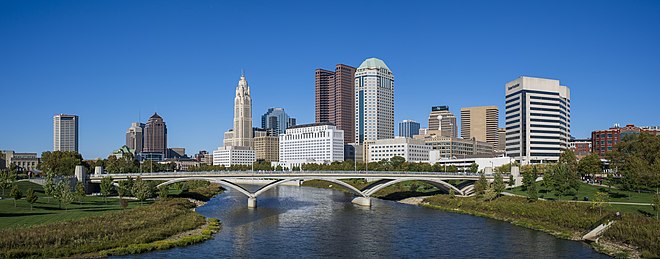
The James A. Rhodes State Office Tower is a 41-story, 629-foot (192 m) state office building and skyscraper on Capitol Square in Downtown Columbus, Ohio. The Rhodes Tower is the tallest building in Columbus and the fifth tallest in Ohio. The tower is named for James A. Rhodes, the longest-serving Ohio governor, and features a statue of Rhodes outside the entrance. The building's interior includes a large open lobby with 22 elevators. Higher floors have offices for numerous state agencies. The tower's 40th floor contains an observation deck, open to the public.

Downtown Columbus is the central business district of Columbus, Ohio. Downtown is centered on the intersection of Broad and High Streets, and encompasses all of the area inside the Inner Belt. Downtown is home to most of the tallest buildings in Columbus.
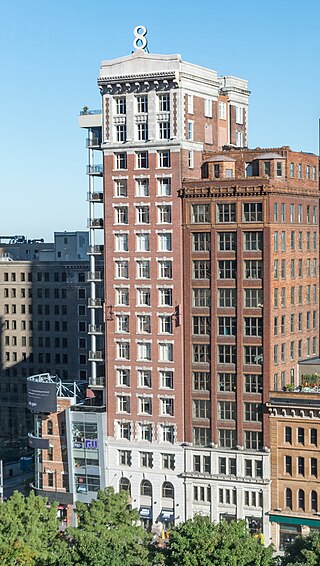
8 East Broad Street is a building on Capitol Square in Downtown Columbus, Ohio. Built in 1906, it was the tallest building in the city until the LeVeque Tower was built in 1927. The architect was Frank Packard. Presently, it is a residential building, housing condominiums in a development called "8 on the Square".
AIA Columbus is a chapter of the American Institute of Architects. Founded in 1913, it is one of the largest urban components of the American Institute of Architects in the Midwestern United States, with members throughout Central and Southeastern Ohio.

Frank L. Packard was a prominent architect in Ohio. Many of his works were under the firm Yost & Packard, a company co-owned by Joseph W. Yost.

Trinity Episcopal Church is a historic church on Capitol Square in Downtown Columbus, Ohio. It was built in 1866 and added to the National Register of Historic Places in 1976.

Richards, McCarty & Bulford was an American architectural firm. The General Services Administration has called the firm the "preeminent" architectural firm of the city of Columbus, Ohio. A number of the firm's works are listed on the National Register of Historic Places. The firm operated until 1943.

Columbus City Hall is the city hall of Columbus, Ohio, in the city's downtown Civic Center. It contains the offices of the city's mayor, auditor, and treasurer, and the offices and chambers of Columbus City Council.

The Toledo and Ohio Central Railroad Station, today named Station 67, is a union meeting space and event hall located in Franklinton, near Downtown Columbus, Ohio. Built by the Toledo and Ohio Central Railroad from 1895 to 1896, it served as a passenger station until 1930. It served as an office and shelter for Volunteers of America from 1931 to 2003, and has been the headquarters of International Association of Fire Fighters Local 67, a firefighters' union, since 2007. The building was placed on the National Register of Historic Places in 1973. During its history, the building has experienced fires and floods, though its relatively few owners have each made repairs and renovations to preserve the building's integrity. The building is the last remaining train station in Columbus.

The Atlas Building, originally the Columbus Savings & Trust Building, is a high-rise building in Downtown Columbus, Ohio, built in 1905 and designed by Frank Packard. It was added to the National Register of Historic Places in 1977. The building has seen two major renovations, in 1982 and 2014.

Governor James A. Rhodes is a 1982 bronze statue depicting Ohio governor Jim Rhodes by Gary Ross, installed along East Broad Street in front of the Rhodes State Office Tower in Columbus, Ohio, United States.

Capitol Square is a public square in Downtown Columbus, Ohio. The square includes the Ohio Statehouse, its 10-acre (4.0 ha) Capitol Grounds, as well as the buildings and features surrounding the square. The Capitol Grounds are surrounded to the north and west by Broad and High Streets. These are the main thoroughfares of the city since its founding. They form the city's 100 percent corner. The grounds are surrounded by 3rd Street to the east and State Street to the south. The oldest building on Capitol Square, the Ohio Statehouse, is the center of the state government and roughly in the geographic center of Capitol Square, Columbus and Ohio.
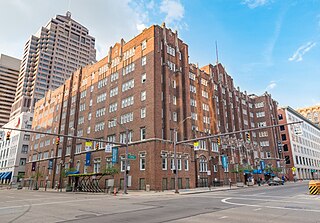
The Downtown YMCA is a historic former YMCA building in Downtown Columbus, Ohio. It was the largest YMCA resident facility in the United States. It was listed on the National Register of Historic Places in 1993. The seven-story building was designed in the Jacobethan Revival and Late Gothic Revival styles by Chicago architecture firm Shattuck & Layer.

The Columbus Civic Center is a civic center, a collection of government buildings, museums, and open park space in Downtown Columbus, Ohio. The site is located along the Scioto Mile recreation area and historically was directly on the banks of the Scioto River.

The 1887 Franklin County Courthouse was the second permanent courthouse of Franklin County, Ohio. The building, located in the county seat of Columbus, stood from 1887 to 1974. It replaced a smaller courthouse on the site, extant from 1840 to c. 1884. The 1887 courthouse deteriorated over several decades, and the site was eventually replaced with Dorrian Commons Park, open from 1976 to 2018; the court moved to a new building nearby. As of 2020, the site is planned to once again hold the county's Municipal Court building.

The former Columbus Railway, Power & Light office is a historic building in the Milo-Grogan neighborhood of Columbus, Ohio. The two-story brick structure was designed by Yost & Packard and built in the 1890s as a transportation company office. The property was part of a complex of buildings, including a power plant, streetcar barn, and inspection shop. The office building, the only remaining portion of the property, was utilized as a transit office into the 1980s, and has remained vacant since then. Amid deterioration and lack of redevelopment, the site has been on Columbus Landmarks' list of endangered sites since 2014.

The Columbus Board of Trade Building was a historic building on Capitol Square in Downtown Columbus, Ohio. The building was built in 1889 for the present-day Columbus Chamber of Commerce, and was designed by Elah Terrell and Joseph W. Yost. It became vacant in 1964 and was demolished five years later. The Rhodes State Office Tower sits on the site today.
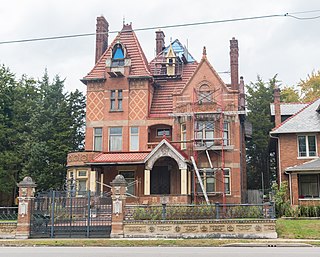
The Charles Frederick Myers house is a historic private residence in the Franklin Park neighborhood of Columbus, Ohio. The house was built in 1896 in an eclectic style. It was added to the Columbus Near East Side District in 1978, and the Bryden Road District in 1990.
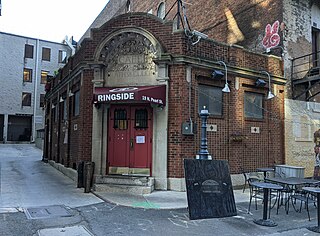
Ringside Café is a restaurant and bar in Downtown Columbus, Ohio. The restaurant is considered the oldest bar or restaurant in Downtown Columbus, having opened in 1897 and operated continuously since then. The restaurant has always been an attraction of politicians, lawyers, reporters, and lobbyists, given its proximity to the Ohio Statehouse, Columbus City Hall, and other government buildings.

The Fair Avenue Elementary School is a historic school building in the Franklin Park neighborhood of Columbus, Ohio. The building contributes to the Columbus Near East Side District, on the National Register of Historic Places. It was built in the Richardsonian Romanesque style in 1890, having been designed by prolific Columbus architect Frank Packard. The building, originally housing a school as part of the Columbus Public School District, currently houses one of three campuses of the A+ Arts Academy.


